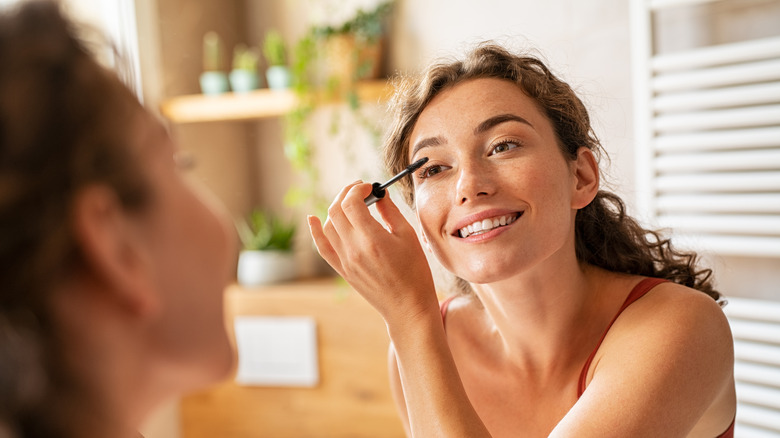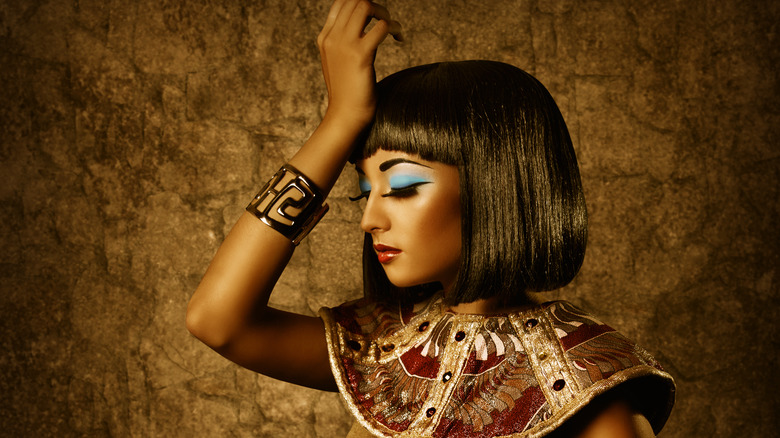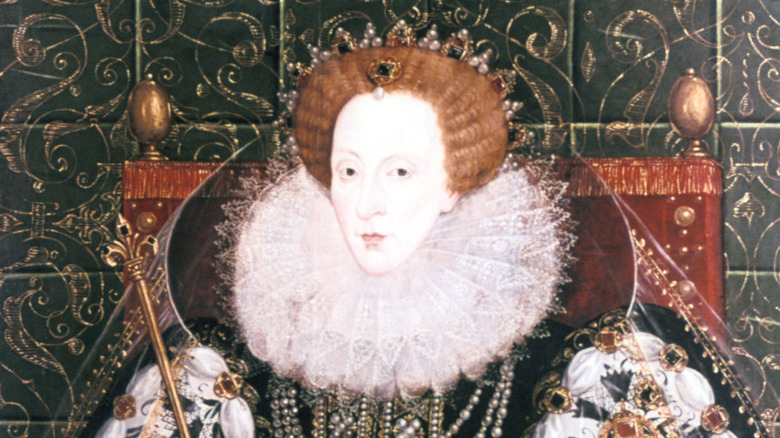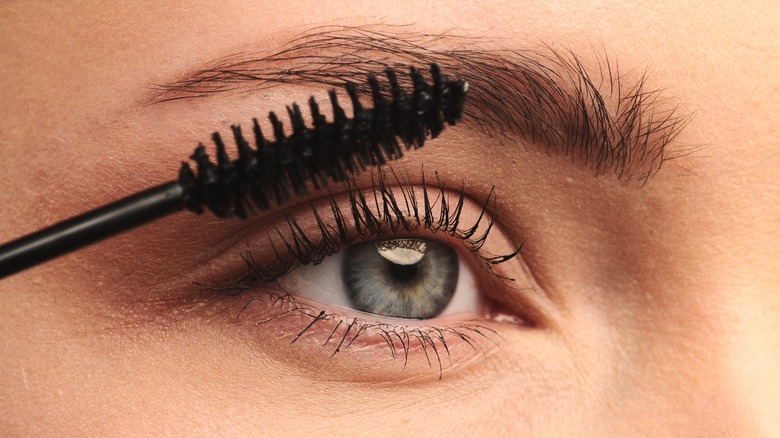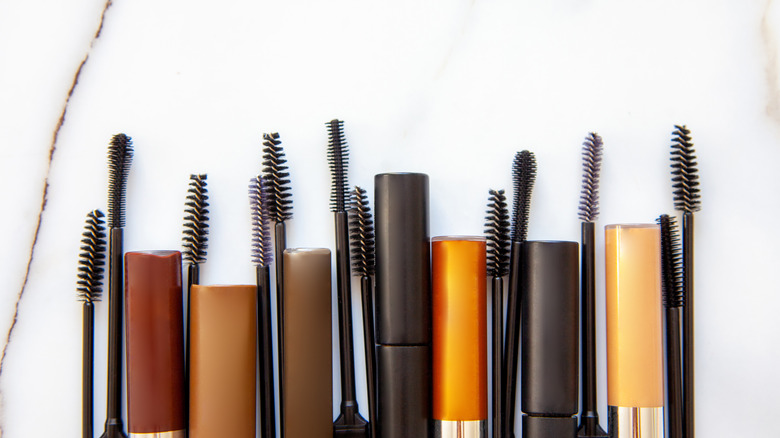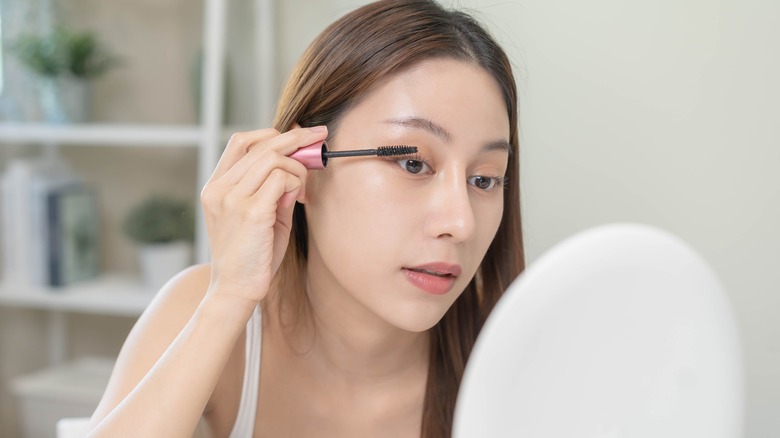The Shockingly Gross History Of Mascara
While anyone wishing to enhance their lashes these days has their pick of countless mascara brands and formulas, there was once a time when people were willing to use just about anything (crocodile dung, anyone??) to get the job done. Many current mascara brands boast labels like "ophthalmologist tested," "clean," "non-toxic," and "hypoallergenic" to assure potential customers that what they're putting near their precious eyes is safe. But no such labels could ever have been slapped onto the original, ancient formulas of this makeup staple.
In fact, from the time of the ancient Egyptians all the way up through the Victorian era, while the formulations changed depending on the era and the location, each makeshift eyelash enhancer had one thing in common with the rest: you probably wouldn't want to put them anywhere near your eyes now that we have a better understanding about both toxicity and infection (via Entrepreneur).
The ancient origins of mascara
In the days of famous Egyptian Queen Cleopatra, both men and women enhanced the appearance of their eyes by smearing a sticky, black paste of sorts onto their lashes and eye area using an instrument made of either ivory or bone (via Entrepreneur). While the ingredients tended to vary, the most common components of this ancient "mascara" included burnt almonds, kohl, honey, water, and the primary ingredient: crocodile dung. Yes, really.
The ancient Romans also used a form of mascara to play up their lashes, though in this culture it was usually done by women, as the look of darker, enhanced lashes was said to represent chastity (via Maybelline). While there was no animal excrement in their formulation, it still doesn't sound like the safest stuff to put on your eyes. The Romans used a mixture of kohl, burnt cork, rose petals, date pits, ashes, and soot, depending what was available to them.
From the Renaissance to the Victorian Age
Flash forward to the European Renaissance, and there was a whole new trend in town (via Marie Claire). At the time, the part of the face considered most beautiful wasn't the eyes or lips as we might feel today; it was the forehead. As such, women of that era actually tried to play down their eyes and eye brows to make their foreheads appear more prominent. This included everything from plucking lashes and brows to even plucking their hair from the front of their heads to recede their hairlines on purpose.
To make things even more interesting, when Queen Elizabeth I of England took the throne, her fiery red hair became in-fashion. In an attempt to get the look, women took to dyeing their lashes and brows with rudimentary means that often caused those lashes to fall out. This wouldn't have likely concerned them terribly, however, since that was part of the look of the day anyway.
When the Victorian age arrived, lashes were back in style again, and ladies were looking to play up their eyes (via Entrepreneur). Women of the day used coal dust and/or lampblack (burnt oil from oil lamps) to get the job done. In 1872, French perfumer Eugène Rimmel (yes, of now-famous Rimmel London cosmetics) created the first commercially available mascara, which was a simple combination of coal dust and petroleum jelly.
Modern ingredients to steer clear of
In 1917, siblings Maybel and Thomas Lyle Williams invented what they called the "first modern eye cosmetic for everyday use," which was petroleum jelly mixed with an undisclosed combination of "oils." This is how the still-famous Maybelline Cake Mascara was born (via Maybelline). We also have Maybelline to thank for the first-ever widely available commercial mascara sold in a tube, which was released in 1960.
Since then, the mascara competition has exploded, with countless brands and formulas vying for the dollars of beauty lovers. Currently, mascara is an incredible $13 million business, and it is only growing (via Market Research Future). And while we may no longer use crocodile droppings in the formulations, that's not to say there aren't ingredients in modern mascara that you probably want to steer clear of. It's a good idea to check the labels of your mascara for potentially-allergenic preservatives known as parabens, as well as for neurotoxic aluminum powder, and coal tar dyes which are known to be carcinogenic (via Entrepreneur).
Choosing a mascara
For those looking for mascaras with cleaner ingredients, Southern Living has rounded up a list of their favorites, which include Tarte's SEA Surfer Curl Volumizing Mascara, which along with being clean is also certified vegan. ILIA's Limitless Lash Lengthening Mascara also makes their list, as does Kosas The Big Clean Volumizing + Lash Care Mascara. For a drugstore brand, Southern Living suggests Cover Girl's Lash Blast Clean Volume Mascara, which is free of parabens, talc, sulfates, and mineral oil.
For a longer list of safe and clean mascaras, we suggest checking out the Environmental Working Group's roundup of their EWG Verified mascaras. There are dozens of brands and formulas that received a green light from the environmental watch dog group, including mascaras from Well People, Honest Beauty, Rimmel London, and Huda Beauty.
And besides checking these lists, it's always a good idea to check the labels of a mascara before you buy it to ensure it doesn't contain anything you are personally allergic to or wish to avoid, and to check if it has other labels you might care about if you are vegan, vegetarian, or gluten free.
Tricks to get the best wear out of your mascara
Since we no longer have to rely on an instrument made of bone to apply mascara to our lashes, we have the opportunity to play with technique a little to ensure we get the look we're going for. Thankfully, Cosmopolitan, the bible for all things beauty, has some tips to ensure you're getting the most out of your mascara.
The first suggestion from Cosmo is that rather than simply sweeping the mascara wand upwards from the base of your lashes to the tips, wiggle the wand back and forth starting at the base as you swipe up, and blink gently as you go. This will help lift your lashes higher and also get the product onto more of your lashes, keeping them separated. Then, depending on the look you're going for, you can apply another layer the same way, and even another if you want to. If you're going for a softer, more natural look, sticking with one layer is a good idea. But if you're looking for a big, bold look reminiscent of falsies, consider two or more coats.
So be safe, have fun, and just be glad you're not scraping soot out of the fireplace for your that smokey eye look!
